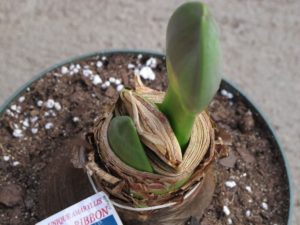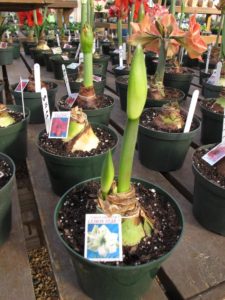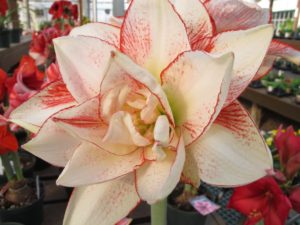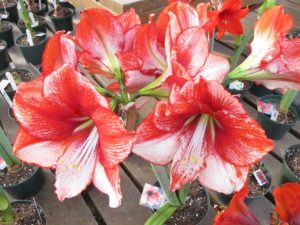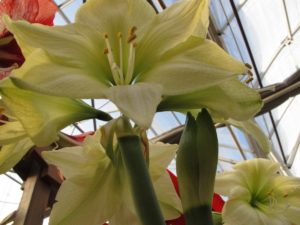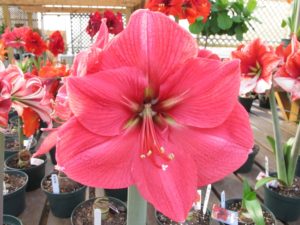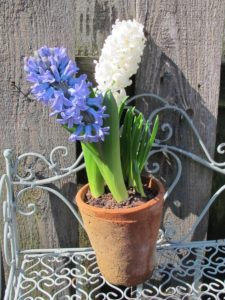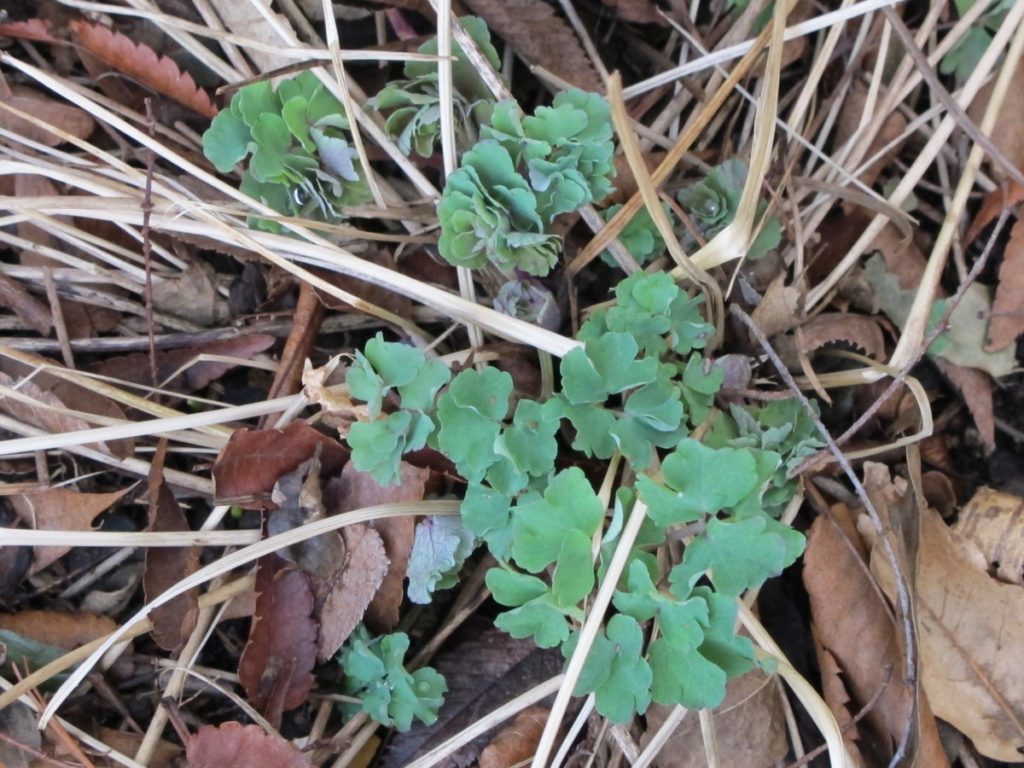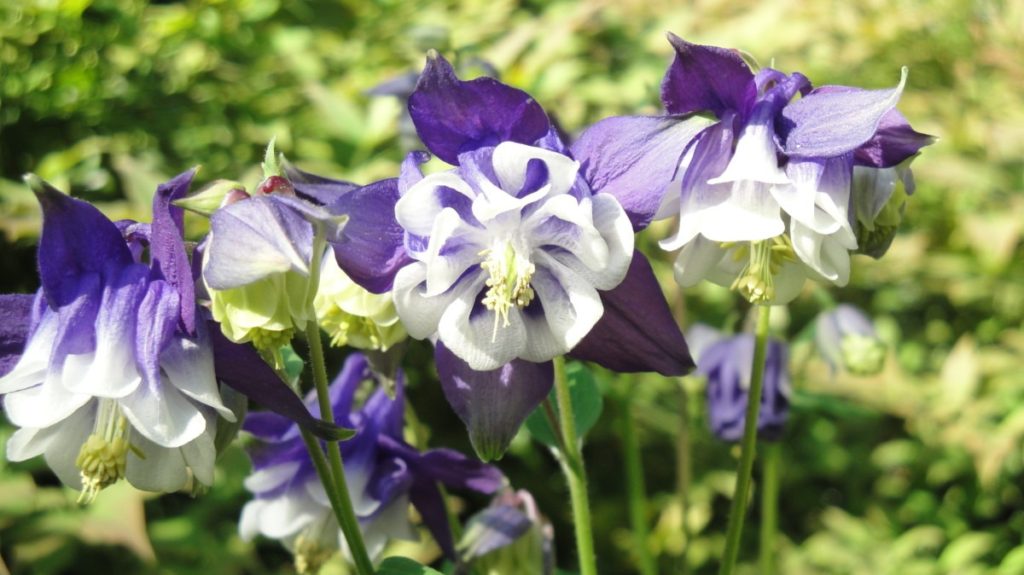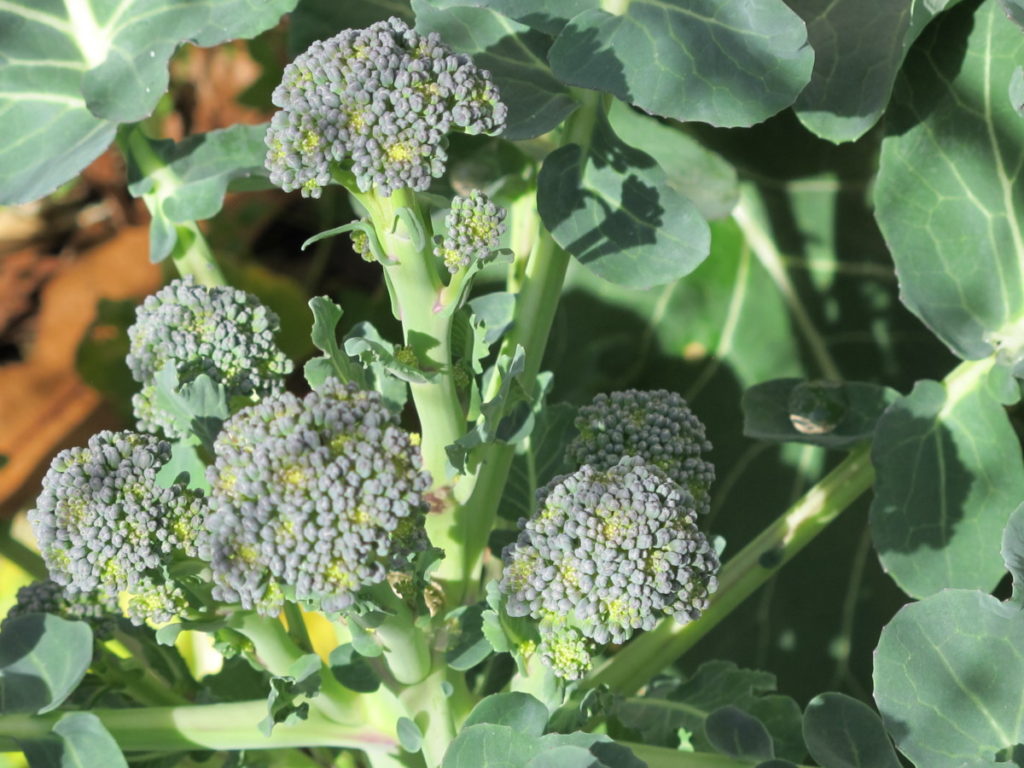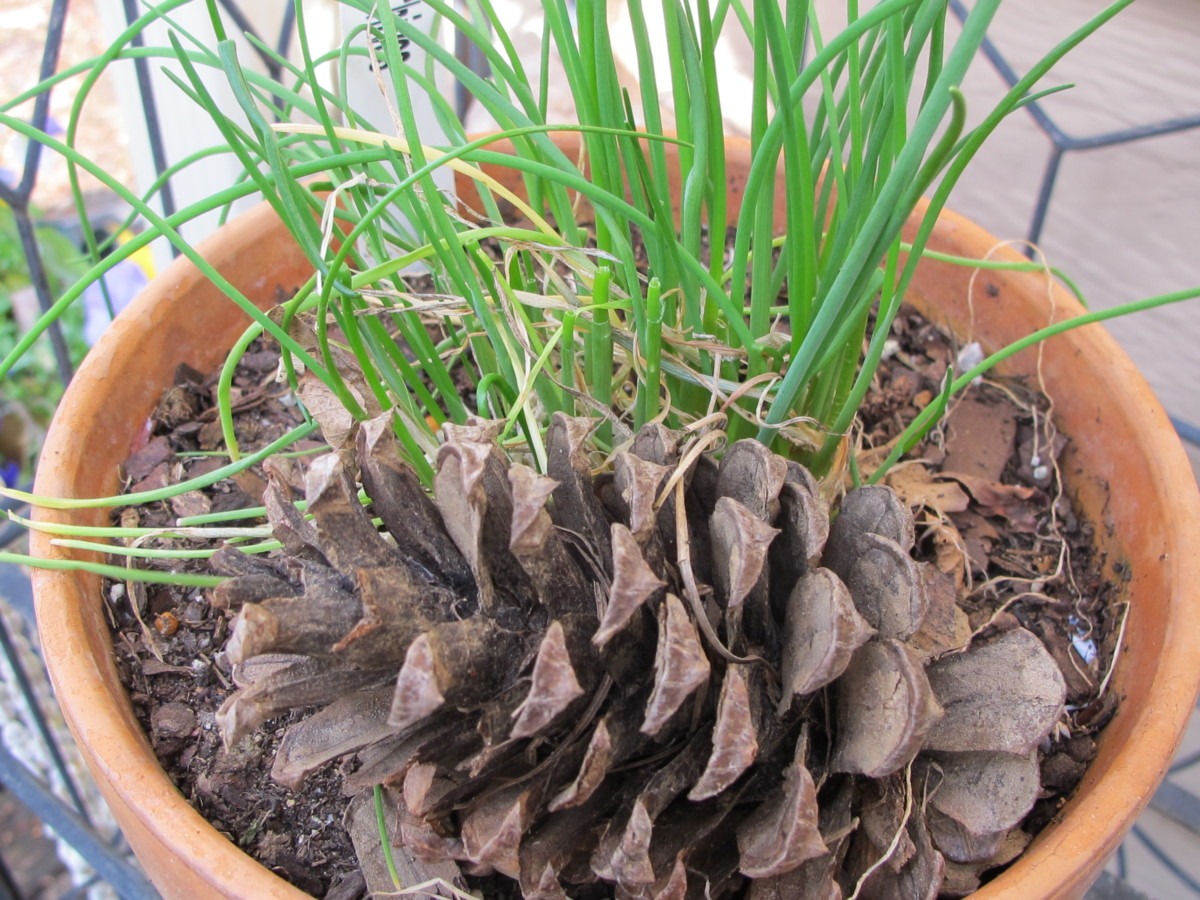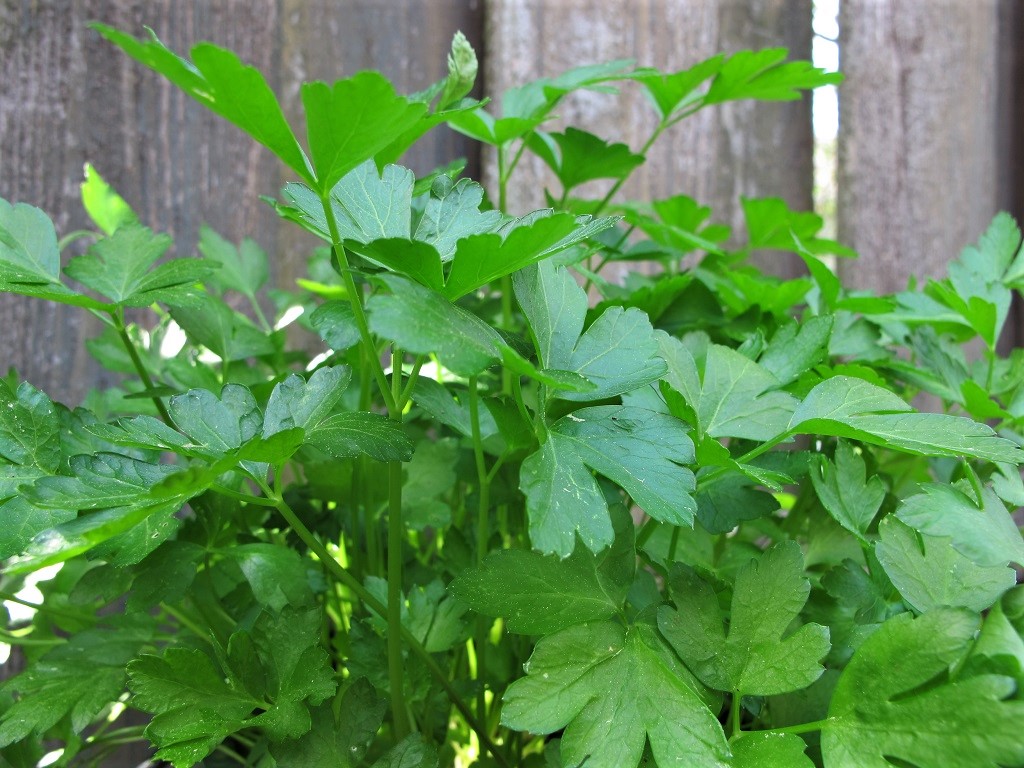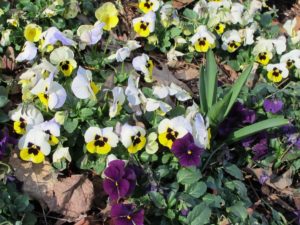Page 2
Finally, Amaryllis!
Yes, blooming amaryllis usually is sold around the winter holidays, and dormant bulbs are available well before that. Because our leafy plants stay outside until late autumn, protected from frost, the bulbs continue to increase in size. A bigger bulb means more flowers, although they start opening much later.
Here’s our first amaryllis bloom (photo, above), and many others are budding up. They’ll stay indoors until the weather is warm enough to move them outside. But, on warm winter and early spring days, I place the flats of plants outdoors to get a few hours of sun. That will help the flower stems grow strong so I won’t have to stake them.
Here are more amaryllis growing at Rountree Nursery and Supply in Charlotte NC, where I worked for a few years. Large bulbs have more flower buds, safely tucked inside. So, if you keep the plants after they bloom, give them lots of sun, fertilize regularly, and keep the soil damp but not wet. As the leaves photosynthesize, carbohydrates are deposited into the bulb, bulking it up for the next bloom cycle.
- Two flower buds emerging from bulb.
- Double flowering amaryllis.
- Amaryllis, blooming in winter.
- Lemon Lime amaryllis.
- Hercules amaryllis.
“Can I Plant Amaryllis Outdoors?”
Gardeners living in Zone 7b and south can plant amaryllis outside in very well-drained soil. The bulb must be planted a couple of inches below the frost line. If an unusually cold winter lingers in your location, cover a wide area over the bulbs with a thick layer of mulch to protect them. Once the bloom/leaf/dormant cycle is re-established, they’ll probably flower in early summer.
Keep growing the plants indoors for the winter, and plant them outside in morning to early afternoon sun, after winter frost is over.
Primrose For Spring
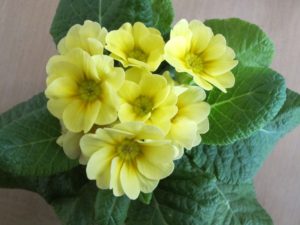
Fragrant primrose.
I bought this primrose a couple of weeks ago at the garden center. The yellow-flowering primroses have a light, slightly citrusy-sweet scent—to me. Others pick up fragrance from red or blue Primula, but yellow is the only one I can smell. Keep primrose cool and moist all the time and it will bloom for a month or two.
Primula acaulis is a hardy perennial, but tends to be targeted by spider mites and thrips in the summer. Grow it in light shade outdoors, in well-composted, moist soil. If it survives the hot summer in this Zone 7b garden, it will start growing and flowering again in late winter.
Forcing Hyacinth Bulbs

An old English clay pot with forced hyacinths.
All the hyacinth bulbs planted in the garden are beginning to show flower buds nestled in the center of the foliage. I forced a few pots of them, and we can’t wait for them to bloom with their room-filling fragrance. The scent is a strong one, maybe less objectionable than paperwhites…but powerful! Once it turns a bit musty, the pot goes outside, until more buds emerge.
A few pots of forced hyacinths and daffodils stayed outside on the covered porch inside an insulated bin, next to the house wall. A large bag of potting soil inside the bin held enough heat, gained in the daytime, to keep them cozy. I loosely draped the top of the bag over the pots. This area receives morning sun, so the bin can warm up early in the day.
I don’t move them to a warmer location unless the temperatures fall below 20°F at night. If I thought the bulbs could freeze, I would move the bin indoors at night, next to a chilly door. Some winters are so mild that the potted bulbs require no protection beyond keeping them close to the house. The larger, layered lasagna pots are given special consideration.
Gardeners living in cold climates need to prevent alternate freezing and thawing, which could damage or kill the bulbs. A lightly heated shed, a chilly basement (low 40’s F), or an unheated sunroom could work.
And After They Bloom?
Forced bulbs continue growing foliage indoors, although I’ll place them outside on mild winter days. Water the pots as needed, and give your plants a dilute solution of fertilizer every month after flowering is finished. Once hard freezes are over, I’ll plant them out in the garden. Crocus, daffodil, and hyacinth are among the easiest species to force and to grow on in the garden.
Usually it’s necessary to dig a deeper hole in the garden in order to set the bulb at the proper depth. But, don’t fill in the hole all the way just yet. Because bulbs are planted more shallowly when forcing, setting them into the garden at the right level would mean covering the base of the leaves with soil, which will rot the foliage.
Keep the green leaves functioning for as long as possible, and don’t cut them off. Instead, wait until the leaves turn yellow naturally, as they enter summer dormancy, before filling in the hole. Forced bulbs usually require a year or two in the garden before they will resume blooming on schedule.
Daffodils
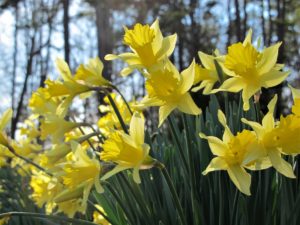
Deer won’t eat daffodils (February).
If you have daffodils in the garden, cut a bunch of them and embellish the vase with twigs from the yard. Daffodil sap can damage other cut flowers, so they are best kept by themselves in a vase.
Every flower stand, florist, or farmers’ market has cut daffodils and tulips in late winter and spring. These flowers evoke the promise of spring, with lengthening days and warming sunshine.
If you’ve had trouble with deer eating your flowers, try planting some daffodils, which are poisonous to warm-blooded animals.
Columbine
- Emerging foliage of columbine.
- Columbine flowers.
A “fast responder” to the warming rays of the spring sun is this columbine (Aquilegia cv.). The local deer found it, even though it’s tucked into the garden next to some shrubs near the front door. Although columbine is often found on lists of “deer tolerant plants”, this one was frequently nibbled back.
When I prepared a solution of Deer Stopper for the violas, the columbine also was sprayed. It regrows quickly, though, if I was too late with the spray.
The Vegetable Garden
- Broccoli ‘Arcadia’ side shoots.
You might have gotten the impression from reading some of these posts that I really, really, enjoy the vegetable garden. And you’re right; I do! But there’s something about the cool season greens and veggies that I love. Maybe it’s because I’m convinced that, more than any other group of foods, brassicas and dark green leafy vegetables provide more of the nutrients that keep our systems running smoothly and help protect us from disease. In other words, they love us back!
The garden has yielded several broccoli crowns and heads of cauliflower, lots of ‘Florida Broadleaf’ mustard greens, almost all the green onions…and all the kale and collards, parsley and arugula I’ve needed in the kitchen. Lettuce seedlings and Swiss chard survived the winter, and the peas planted last fall are beginning to flower. Overall, this was another warm winter, but on those nights that “plummeted” below 25°F, I suspended large sheets of plastic over the garden to protect the plants.
The broccoli’s side shoots are ready to pick. It will develop a few more rounds of side shoots before it gets too warm for broccoli. And now and then a broccoli leaf comes into the kitchen for a stir-fry, soup, or salad.
Herbs
- Hardy chives.
- Flat-leaf parsley.
Cold-hardy herbs grow unfazed by the chill, on the deck just a few feet from the kitchen. Here, they’re protected from rabbits and deer. I fertilize them every 6 to 8 weeks, as long as the soil is unfrozen, and more often in summer. We keep flat leaf (aka, plain or Italian) parsley, chives, bay, sage, marjoram, and thyme in pots. Basil enjoys a warm sunny window indoors.
Chives is a super-hardy perennial herb. Related to the onion, chives produces small bulbs in the soil. Very cold winter weather causes it to go dormant, but it’s always the first herb to start growing again in the spring. Over this mild winter, though, some of the foliage remained green.
Harvest a few leaves of chives all the way down to the soil, and the bulbs will send up new leaves. Cutting it this way prevents the tips of the leaves from turning yellow as they do when they’re clipped across the top. The sharp tips of the pine cone nestled into the soil (photo, above) prevent squirrels from disturbing the pot.
Late winter through early fall is a good time to divide an older clump of chives.
- Italian oregano in the garden at the end of winter.
- Fresh and dried oregano.
Italian oregano is a clump-forming hardy perennial herb that we enjoy in soups, sauces, Italian dishes, and salad dressing. This one is sweeter than Greek oregano, and it dries well for winter use. A few times during the growing season, I’ll harvest long leafy stems, wash them, and lay them on a dish to dry.
Harsh winter conditions normally cause oregano to go completely dormant, but a tuft of greenery stayed alive this winter.
Viola
A bed of purple, yellow, and white violas, smaller cousins of the pansy, grows outside the front door and is a welcome sight every day. They are edible, but, because I spray them with deer repellent, they go into a tiny vase instead of into the salad.
You can see (photo, above) a hyacinth bulb’s foliage growing through the violas. In fact, about a hundred mixed bulbs live in this garden—scillas, daffodils, hyacinths, Muscari (grape hyacinth), and Hyacinthoides.
Pansies have larger flowers, but violas bloom better in half-day sun and in cold winters. These cute little flowers have never disappointed us. Spray monthly with deer repellent or suspend deer netting over the bed. Fertilize when new growth resumes, or every 6 weeks if moderate winter weather keeps them blooming.
A Rare and Perfect Day
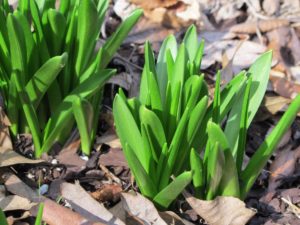
Hyacinthoides hispanica, the wood hyacinth.
Have you ever had one of those “perfect” days, when the temperature is mild and any breeze is so gentle it’s barely noticed? When humidity hangs like the faintest veil, but not uncomfortably so? There’s a quiet stillness about, the kind of day that just feels joyful. Inwardly joyful. There’s no other way to describe it.
For me, it always happens in late winter or early spring…but it doesn’t happen every year. More like once a decade! A customer at the Rockville (MD) Farmers’ Market, where I used to sell plants, was familiar with this phenomenon. It’s good to know others feel it, too.
Last week, on a drive through the countryside two hours west, I saw a slope next to the road that had been ignited by hundreds of bright yellow daffodils. At that elevation (2100′), I expected them to bloom later than those closer to home, at 600′ above sea level. But they might have been earlier varieties, and the slope faced due south, providing a warm microclimate.
That day was one of those joyful days. No, there was no major “riot of color”; it was far too early for annuals. And there was no chocolate in the truck… But there was something in the quality of the air. Hard to describe, but you’ll know it when you experience it.
The first time I felt this, a friend and I had gone for a drive after college classes, in a mint-green mid ’60’s Chevy convertible. We had ice cream from a tiny shop way out in rural Connecticut. It was the kind of place you’re more likely to discover by chance, rather than locate by design. Perfect.
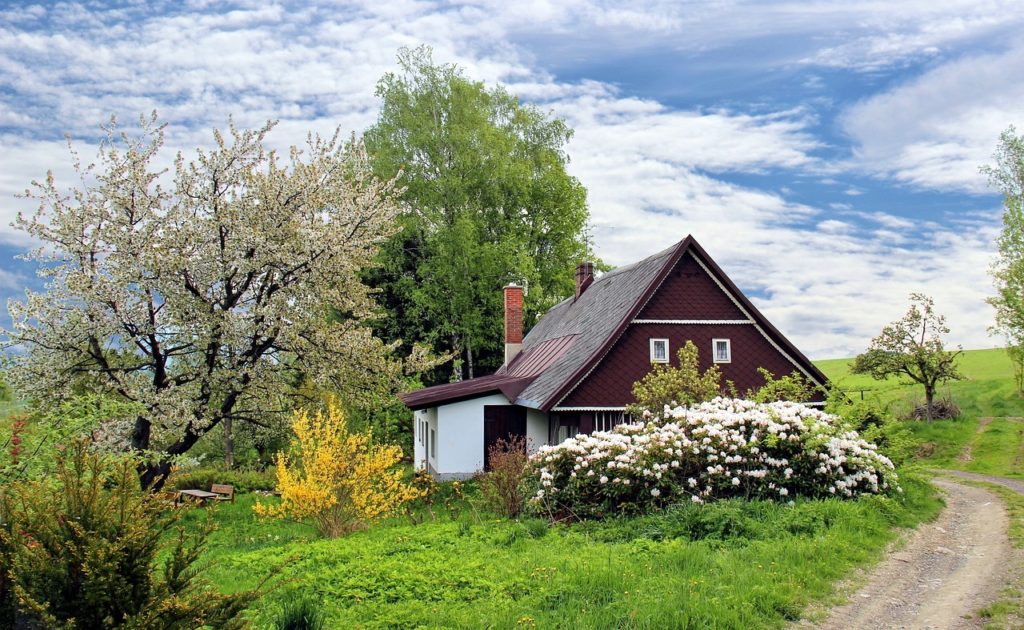
Ah, Spring!
Early blooming cherry trees, golden forsythia, the swelling buds on the blueberry bush, birdsong… What’s happening in your neighborhood?
These are just a few signs that spring is near. Yes, we could still get our share of the white stuff, and that’s fine. It’s still snowing in the northern states, and, although it’s beautiful to watch, it’s not kale. Enjoy!
Headings
Page 1: Early Bloomers, and The ‘Yoshino’ Cherry (In the Landscape)
Page 2: Finally, Amaryllis! (“Can I Plant Amaryllis Outdoors?”), Primrose, Forcing Hyacinth Bulbs (And After They Bloom?, Daffodils), Columbine, The Vegetable Garden (Herbs), Viola, A Rare and Perfect Day, and Ah, Spring!

